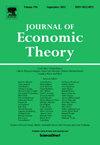自发歧视与内生信息披露
IF 1.2
3区 经济学
Q3 ECONOMICS
引用次数: 0
摘要
我将内生信息披露引入“自发歧视”模型(la Peski and Szentes, 2013)。有限种群中的个体反复决定是否与随机分配或选择的伙伴进行有益的互动。每个人都有固定的身体和动态的社会色彩。社会色彩传达了过去伴侣的颜色信息——但只有当这些信息是由决策者或随机观察者披露的时候。我描述了内源性披露支持低效均衡的条件,在这种条件下,个体通过对潜在伴侣的(与回报无关的)颜色进行条件作用来进行歧视。分析表明,被选为合作伙伴的竞争是如何与歧视性规范相互作用的,从而为信息披露创造了严格的激励机制,从而维持了本来会消失的歧视。本文章由计算机程序翻译,如有差异,请以英文原文为准。
Spontaneous discrimination with endogenous information disclosure
I introduce endogenous information disclosure into a model of “spontaneous discrimination” à la Peski and Szentes (2013). Individuals in a finite population repeatedly decide whether to engage in profitable interactions with a randomly assigned or chosen partner. Each individual has a fixed physical and a dynamic social color. Social color conveys information about the colors of past partners—but only if that information is disclosed by the decision maker or a random observer. I characterize conditions under which endogenous disclosure supports inefficient equilibria where individuals discriminate by conditioning interactions on the (payoff-irrelevant) colors of potential partners. The analysis shows how competition for being selected as partner interacts with discriminatory norms to create strict incentives for information disclosure, thereby sustaining discrimination that would otherwise break down.
求助全文
通过发布文献求助,成功后即可免费获取论文全文。
去求助
来源期刊

Journal of Economic Theory
ECONOMICS-
CiteScore
2.50
自引率
12.50%
发文量
135
期刊介绍:
The Journal of Economic Theory publishes original research on economic theory and emphasizes the theoretical analysis of economic models, including the study of related mathematical techniques. JET is the leading journal in economic theory. It is also one of nine core journals in all of economics. Among these journals, the Journal of Economic Theory ranks fourth in impact-adjusted citations.
 求助内容:
求助内容: 应助结果提醒方式:
应助结果提醒方式:


